![]()
Computer Audio Connectors
This page is an attempt to show examples of some common computer soundcard configurations, with the objective of giving the novice reader a resource with which to identify what equipment he/she has. It is by no means intended to be an exhaustive list of all computer audio devices on the market, nor is it intended to endorse any specific product or brand. It is hoped that this will be a useful reference for anyone who does not know what has been included on his/her computer and wants to find out.
Note that in the cases pictured below, the soundcards shown sometimes contain connectors which are not relevant to a discussion on copying computer audio to minidisc. In every case all connectors are listed; however those connectors that are not appropriate to this discussion are not discussed in detail.
Configurations listed on this page:
| .Analog soundcard | ... | |
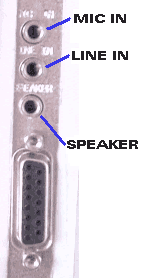
|
Pictured here is a soundcard with analog connections. This is a typical
low-end soundcard. Cards of this nature frequently have a speaker output, a
microphone input and an analog line-in.
Connectors (top to bottom): Microphone in, Line in, Speaker out, Game port Recording options:
Upgrades: Depending on the soundcard, it may be possible to add a daughter card, which will add digital recording capabilities |
|
| . | ||
| .Built-in analog soundcard | ||
 |
This is a built-in analog soundcard. Some computers now come
equipped with the soundcard already built into the motherboard; therefore
there is no need to install one. This type of soundcard is usually very
basic with only a minimum feature set. These cards will generally have a speaker output, a
microphone input and an analog line-in.
Connectors (left top to bottom, right): Headphone out (top left), Line in, Microphone in (bottom left), Game port (right) Recording options:
Upgrades: No upgrades are possible to a built-in soundcard |
|
| . | ||
| .Analog soundcard | ||
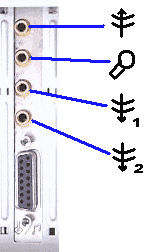 |
This is a different kind of soundcard with analog connections.
This soundcard has pictures instead of words to label the various
connectors. The pictures have been redrawn here because you cannot see
them very well in the picture. The symbols are explained in the list
below. The reason this soundcard has
2 connectors for speaker outputs is that this soundcard is equipped for
surround sound (2 front speakers plus 2 rear speakers).
Connectors (top to bottom): Line-in, Microphone in, Speaker out 1 (front), Speaker out 2 (rear), Game port Recording options:
Upgrades: Depending on the card, it may be possible to add a daughter card for digital I/O capabilities |
|
| . | ||
| .Digital (coaxial) soundcard | ||
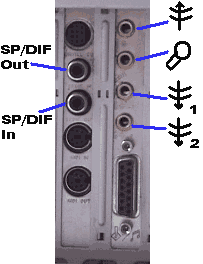 |
This is a soundcard with digital coaxial inputs and outputs.
The symbols and words that are on the card have been redrawn in the
picture because you cannot see them very well. A list below explains what
all of the connectors are for. This soundcard includes a
daughter card for the digital connections, however as you can see the digital
connections are RCA jacks. This is a giveaway clue that this is NOT a digital optical
connection (required by portable minidisc recorders) and therefore cannot directly connect to an MD portable that has an
optical line-in. It also includes a digital DIN jack and Midi in/out, which will
not be discussed on this website. Since this soundcard has a digital
coaxial out and minidisc portables require a digital optical input, it is
not possible to record directly from this soundcard to a portable minidisc
digitally. It is possible, however, to record from this soundcard to a
portable minidisc using an analog connection.
Connectors (top left to bottom left; top right to bottom right): Digital DIN, SP/DIF out (coaxial), SP/DIF in (coaxial), Midi out, Midi in (bottom left), Line in (top right), Microphone in, Speaker 1 out (front), Speaker 2 out (rear), Game port (bottom right) Recording options:
Upgrades: If the soundcard already has some type of daughter card, it is very likely that the existing coaxial daughter card could be replaced by an optical daughter card, which would ensure the ability to digitally copy audio from the computer to the minidisc. It may also be possible to add a second daughter card onto the existing one, if both are needed (see the section on daughter cards). Check with your soundcard's manufacturer for details. |
|
| .Digital coaxial (miniplug) soundcard | ||
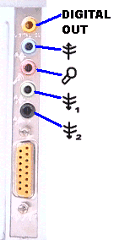 |
This is a soundcard made by a company called Creative with five miniplugs which includes a "digital out".This card is labeled with symbols instead of words, and the symbols have been enlarged in the picture to the left to make them easier to see. Unfortunately, this "digital out" is a bit deceptive since it does not conform to the SP/DIF standard. It is a proprietary form of "digital out" which is designed to be used with Creative's "digital speakers" (again a deceptive term since all speakers are analog, not digital). At any rate, this "digital out" cannot be used to record to Minidisc (or anything else). In rare cases you might find a soundcard that actually has an optical miniplug digital out. How to tell the difference between a digital coaxial and digital optical miniplug? If the jack labeled "Digital out" had a bright red light inside after the computer is booted up, it would be a digital optical jack. This one has no light inside (it looks just like all of the other miniplug jacks on this soundcard); therefore it is not a digital optical out. Although it is not possible to record digitally from this soundcard to a portable minidisc, it is possible to record in analog. Connectors (top to bottom): Digital coaxial out, Line in, Microphone in, Speaker 1 out (front), Speaker 2 out (rear), Game port Recording options:
Upgrades: Depending on the card, it may be possible to add an optical daughter card for optical digital I/O capabilities |
|
| . | ||
| .Digital Optical/coaxial soundcard | ||
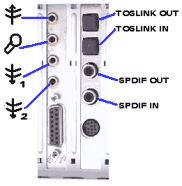 |
This is a soundcard that includes digital optical inputs and
outputs and digital coaxial inputs and outputs. The digital optical and
coaxial connections are located on a separate daughter card. This is an ideal
card for recording from computer to minidisc, because it has the ability to
record from the soundcard's digital optical "out" to the minidisc's
optical "in". It also has 2 sets of speaker outputs, for surround
sound capability.
Connectors (top left to bottom left; top right to bottom right): Line in, Microphone in, Speaker 1 output (front), Speaker 2 output (rear), Game port, Digital optical out, Digital optical in, Digital coaxial out, Digital coaxial in, Digital DIN Recording options:
Upgrades: Why would you want to upgrade? This card has everything!! |
|
| . | ||
| .Notebook soundcard | ||
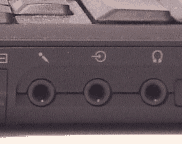 |
This is the "soundcard" on a typical notebook
computer. Notebooks do not actually have a sound card per se; rather they
have all the soundcard circuitry already integrated onto the motherboard.
Typically there is no digital I/O, so with a notebook the only way to
record is usually analog.
Connectors (left to right): Microphone in, Line in, Headphone out Recording options:
Upgrades: Generally notebook soundcards cannot be upgraded. However, some notebooks have docking stations with enhanced capabilities and there are always external devices that can be added. |
|
| . | ||
| .USB port | ||
 |
Pictured here are two typical USB ports. USB ports are used
for almost everything on computers now, and therefore USB ports are not
strictly considered to be "audio" devices. However, USB ports
can be used to record audio from a computer, and in some situations the
USB port might be the best alternative.
Connectors: USB Recording options: Upgrades: N/A |
|
 |